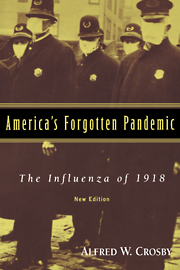Book contents
- Frontmatter
- Contents
- List of Graphs and Tables
- Preface to the New Edition
- PART I An Abrupt Introduction to Spanish Influenza
- PART II Spanish Influenza: The First Wave—Spring and Summer, 1918
- PART III The Second and Third Waves
- PART IV Measurements, Research, Conclusions, and Confusions
- 11 Statistics, Definitions, and Speculation
- 12 Samoa and Alaska
- 13 Research, Frustration, and the Isolation of the Virus
- 14 Where Did the Flu of 1918 Go?
- PART V Afterword
- Index
11 - Statistics, Definitions, and Speculation
Published online by Cambridge University Press: 05 June 2012
- Frontmatter
- Contents
- List of Graphs and Tables
- Preface to the New Edition
- PART I An Abrupt Introduction to Spanish Influenza
- PART II Spanish Influenza: The First Wave—Spring and Summer, 1918
- PART III The Second and Third Waves
- PART IV Measurements, Research, Conclusions, and Confusions
- 11 Statistics, Definitions, and Speculation
- 12 Samoa and Alaska
- 13 Research, Frustration, and the Isolation of the Virus
- 14 Where Did the Flu of 1918 Go?
- PART V Afterword
- Index
Summary
Now we must stretch a tape measure along the shoulders and flanks of the cataclysm. How many did Spanish influenza strike, and how many died?
First, the chronological limits of the pandemic must be set. It seems clear that Spanish influenza first appeared in early spring 1918 in a mild form, and that its most deadly variant appeared in August of that year. When did the pandemic end? That is more difficult to say, for while flu pandemics often begin abruptly, they normally disappear only after several renewals of virulency and then a long tailing off.
The pandemic of Spanish influenza subsided and sank below the level of general and even scientific perception in the United States and almost everywhere else in the world in spring 1919. It rallied in January and February 1920, cursing that year with the highest death rate of the century for flu and pneumonia in the United States, with the exception of only the two preceding years. It is almost certain that the 1920 epidemic was of Spanish influenza, because the abnormally high proportion of deaths among young adults, the unique characteristic of 1918 and 1919, continued right through 1920.
But the 1920 edition of the Spanish influenza virus was an attenuated variant of the original strain, and the human population was more resistent than in 1918 and 1919. Although such cities as Detroit, Milwaukee, Minneapolis, and St. Louis suffered severely, in general the number of cases and of pneumonic complications and deaths was much lower than in the autumn ending the war and the winter of the peace conference.
- Type
- Chapter
- Information
- America's Forgotten PandemicThe Influenza of 1918, pp. 203 - 230Publisher: Cambridge University PressPrint publication year: 2003



